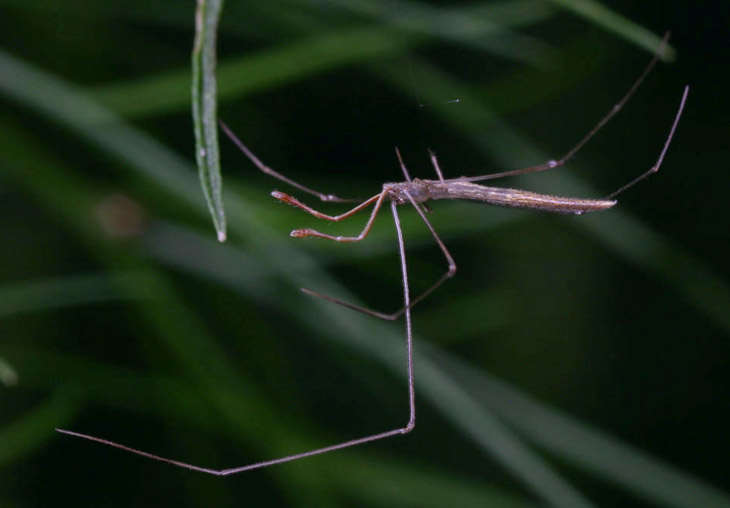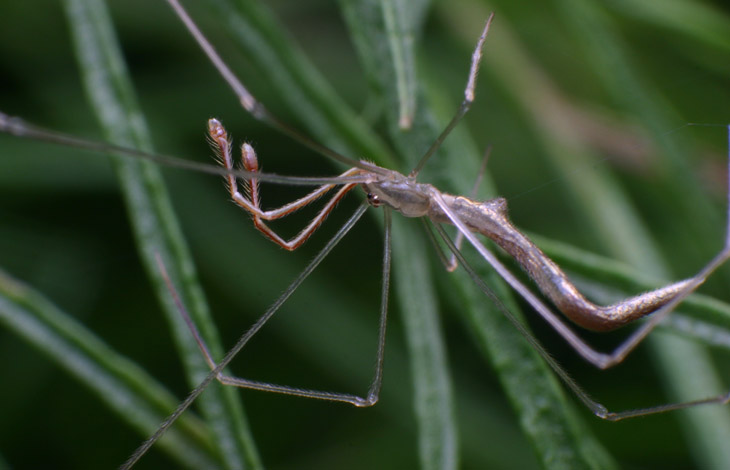Several weeks back, I was contacted out of the blue (rather than out of the yellow or the aubergine, which are much less abrupt) by Catherine Scott, a biologist/entomologist that specializes in spiders; she had seen some of my images on BugGuide.net and wanted permission to use them in a post on her own blog, SpiderBytes. After a lengthy and heated discussion on terms (me: “Sure!”) I sent her over some copies, and then just checked occasionally to see what new posts were appearing because, you know, spiders. Now, I never intended to concentrate on arachnids with my photographic pursuits, but they’re what I’m finding the most of, and they’re admittedly pretty interesting on their own.
Her post featuring my images snuck in between checks, so I’m a little late, but it can be seen right here. And she had a similar experience to my own with her first encounter. Mine was several years back on the dog fennel plants, which had provided tons of photo subjects; I first thought I’d spotted a thin-bodied variety of assassin bug such as the Metapterini, for which I think I can be excused. Upon realizing that my tiny subject was an arachnid, I also suspected the long-jawed orb weavers (Tetragnathids,) but BugGuide wasn’t providing any matches, plus the chelicerae that prompted the name weren’t actually long (what you’re seeing here are the pedipalps, not the chelicerae/fangs.) After a lot of searching, I finally uploaded the photos to BugGuide and received an answer almost immediately. My photo subject was a Rhomphaea fictilium, but that’s probably obvious once you see the image below.

Now for the part that I think I noticed, but never really put together, which she makes clear in her own post. Unlike every other arachnid I’ve seen, Rhomphaea have the ability to alter the shape of their abdomens, and I actually caught this in two of my images; I think I suspected I had two different individuals, since the images were shot on consecutive days, even though they were both in the same area and have never been seen since – both were also males. If you look at the image above, you can see that the abdomen extends just beyond the first joint of the hind legs, though in other images it seems to stop just shy of that point. Contrast that, however, with the next image:

Obviously, a lot longer here, and bent to match the joints of the hind legs. According to Catherine, this flexibility could be to help them camouflage themselves. Also note the location of the spinnerets producing the webbing, not at the end of the abdomen as expected, but well up towards the base and protruding noticeably – a fine line of web can just barely be seen extending from it off towards the right.
She pointed out another trait, one that I sort-of captured in my images, seen in her post and on BugGuide. Rhomphaea prey on other spiders, and apparently can find the web of another species and mimic the vibrations of tangled prey with their forelegs, bringing the other spider racing out to snag their ‘capture,’ only to be captured by Rhomphaea instead.
[Knock knock]
“Who’s there?”
[Trying to disguise voice] “Um, a mosquito.”
“Be right out, don’t go away!”
I’ll let you dwell on that mental image as I plow on.
Now, I’d love to capture more images of behavior such as this, and have tried, really, without much luck. Part of the problem might be that my looming presence is enough to alter the behavior of any arthropods within visible range, and I have seen supporting evidence for this. Another reason might be that such encounters are few and far between, and I would have to stalk one particular subject for hours or days on end to see such drama. I have, on occasion, spent quite a bit of time on observing one form of behavior or another, but this tends to be when I already see it happening; I don’t recall ever capturing behavior from just following a subject around to see what happened, and often when I’ve tried, nothing has come of it. Perhaps I’m just not trying hard enough.




















































